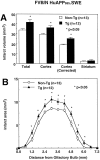Increased susceptibility to ischemic brain damage in transgenic mice overexpressing the amyloid precursor protein
- PMID: 9315887
- PMCID: PMC6793926
- DOI: 10.1523/JNEUROSCI.17-20-07655.1997
Increased susceptibility to ischemic brain damage in transgenic mice overexpressing the amyloid precursor protein
Abstract
We studied the role of the amyloid precursor protein (APP) in ischemic brain damage using transgenic mice overexpressing APP. The middle cerebral artery (MCA) was occluded in FVB/N mice expressing APP695.SWE (Swedish mutation) and in nontransgenic littermates. Infarct volume (cubic millimeters) was assessed 24 hr later in thionin-stained brain sections. The infarct produced by MCA occlusion was enlarged in the transgenics (+32 +/- 6%; n = 12; p < 0. 05; t test). Measurement of APP by ELISA revealed that, although relatively high levels of Abeta were present in the brain of the transgenics (Abeta1-40 = 80 +/- 19 pmol/g; n = 6), there were no differences between ischemic and nonischemic hemispheres (p > 0.05). The reduction in cerebral blood flow produced by MCA occlusion at the periphery of the ischemic territory was more pronounced in APP transgenics (-42 +/- 8%; n = 9) than in controls (-20 +/- 8%; n = 9). Furthermore, the vasodilatation produced by neocortical application of the endothelium-dependent vasodilator acetylcholine (10 microM) was reduced by 82 +/- 5% (n = 8; p < 0.05) in APP transgenics. The data demonstrate that APP overexpression increases the susceptibility of the brain to ischemic injury. The effect is likely to involve the Abeta-induced disturbance in endothelium-dependent vascular reactivity that leads to more severe ischemia in regions at risk for infarction. The cerebral vascular actions of peptides deriving from APP metabolism may play a role in the pathogenic effects of APP.
Figures





Similar articles
-
Expression of human apolipoprotein E downregulates amyloid precursor protein-induced ischemic susceptibility.Stroke. 2002 Jul;33(7):1905-10. doi: 10.1161/01.str.0000020124.61998.bc. Stroke. 2002. PMID: 12105373
-
Human copper-zinc superoxide dismutase transgenic mice are highly resistant to reperfusion injury after focal cerebral ischemia.Stroke. 1994 Jan;25(1):165-70. doi: 10.1161/01.str.25.1.165. Stroke. 1994. PMID: 8266365
-
β-Amyloid, cholinergic transmission, and cerebrovascular system -- a developmental study in a mouse model of Alzheimer's disease.Curr Pharm Des. 2013;19(38):6749-65. doi: 10.2174/13816128113199990711. Curr Pharm Des. 2013. PMID: 23530514
-
SOD1 rescues cerebral endothelial dysfunction in mice overexpressing amyloid precursor protein.Nat Neurosci. 1999 Feb;2(2):157-61. doi: 10.1038/5715. Nat Neurosci. 1999. PMID: 10195200
-
The amyloid precursor protein in ischemic brain injury and chronic hypoperfusion.Ann N Y Acad Sci. 1993 Sep 24;695:190-3. doi: 10.1111/j.1749-6632.1993.tb23050.x. Ann N Y Acad Sci. 1993. PMID: 8239281 Review.
Cited by
-
Dysfunctional Sensory Modalities, Locus Coeruleus, and Basal Forebrain: Early Determinants that Promote Neuropathogenesis of Cognitive and Memory Decline and Alzheimer's Disease.Neurotox Res. 2016 Oct;30(3):295-337. doi: 10.1007/s12640-016-9643-3. Epub 2016 Jun 23. Neurotox Res. 2016. PMID: 27339162 Review.
-
Cerebral amyloid angiopathy impact on endothelium.Exp Gerontol. 2012 Nov;47(11):838-42. doi: 10.1016/j.exger.2012.08.005. Epub 2012 Aug 28. Exp Gerontol. 2012. PMID: 22944481 Free PMC article. Review.
-
Cyclooxygenase-2 contributes to functional hyperemia in whisker-barrel cortex.J Neurosci. 2000 Jan 15;20(2):763-70. doi: 10.1523/JNEUROSCI.20-02-00763.2000. J Neurosci. 2000. PMID: 10632605 Free PMC article.
-
Age-related impairment of synaptic transmission but normal long-term potentiation in transgenic mice that overexpress the human APP695SWE mutant form of amyloid precursor protein.J Neurosci. 2001 Jul 1;21(13):4691-8. doi: 10.1523/JNEUROSCI.21-13-04691.2001. J Neurosci. 2001. PMID: 11425896 Free PMC article.
-
Progranulin deficiency promotes post-ischemic blood-brain barrier disruption.J Neurosci. 2013 Dec 11;33(50):19579-89. doi: 10.1523/JNEUROSCI.4318-13.2013. J Neurosci. 2013. PMID: 24336722 Free PMC article.
References
-
- Abe K, Tanzi RE, Kogure K. Induction of HSP70 mRNA after transient ischemia in gerbil brain. Neurosci Lett. 1991a;125:166–168. - PubMed
-
- Abe K, Tanzi RE, Kogure K. Selective induction of Kunitz-type protease inhibitor domain-containing amyloid precursor protein mRNA after persistent focal ischemia in rat cerebral cortex. Neurosci Lett. 1991b;125:172–174. - PubMed
-
- Astrup J, Siesjö BK, Symon L. Thresholds in cerebral ischemia—the ischemic penumbra. Stroke. 1981;6:723–725. - PubMed
-
- Banati RB, Gehrmann J, Wiessner C, Hossmann KA, Kreutzberg GW. Glial expression of the beta-amyloid precursor protein (APP) in global ischemia. J Cereb Blood Flow Metab. 1995;15:647–654. - PubMed
-
- Barone FC, Knudsen DJ, Nelson AH, Feuerstein GZ, Willette RN. Mouse strain differences in susceptibility to cerebral ischemia are related to cerebral vascular anatomy. J Cereb Blood Flow Metab. 1993;13:683–692. - PubMed
Publication types
MeSH terms
Substances
Grants and funding
LinkOut - more resources
Full Text Sources
Other Literature Sources
